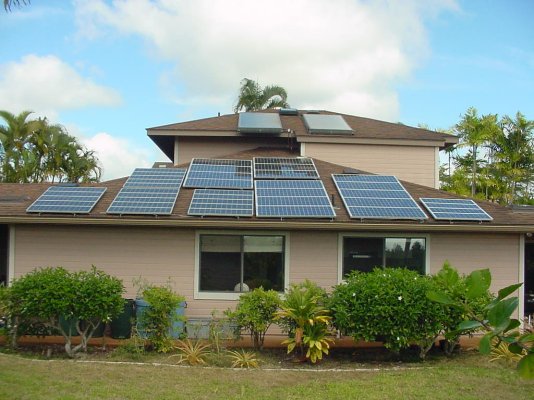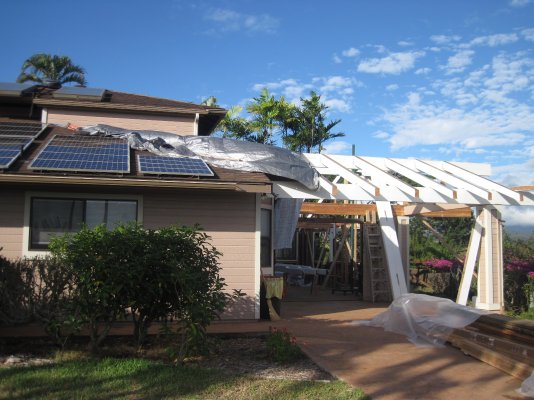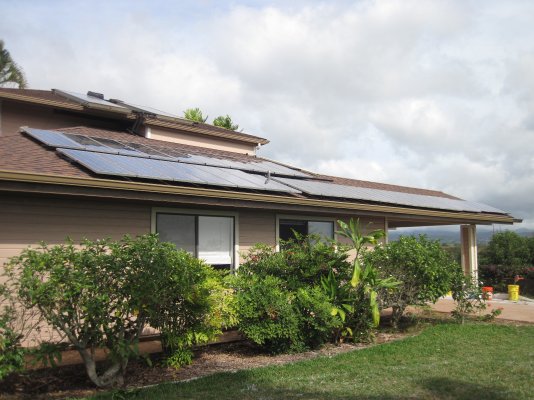He, he - so maybe now you don't want to upgrade your array any more.
But have you noticed that you can buy panels panels on mainland for about $1.50 per Watt nowadays?

That's awesome, isn't it? Our renovation doubled our south-facing roof area, too. At one point the solar supply store and I were seriously contemplating 15 KW and a power-producing agreement, but the numbers don't pencil out because of HECO's monthly fees and 20-year terms.
Interesting! You didn't say it, but you must have installed photovoltaic prior to the roof mods. I've flirted with photovoltaic changes, but I can't make the return numbers work yet. I hear that costs are coming down, but my state doesn't have much of an energy rebate plan. I'm still hopeful costs will come down. (Maybe I need a new roof.

) Did your family room have an attic, or was the ceiling the underside of the roof? Tight
The old familyroom & back lanai roof was flat-- just joists with a BRAI torch-on roof on top and a drywall ceiling below. No insulation or any photovoltaic panels there, just one heck of a thermal gradient from the morning sun. The old kitchen roof had a void between ceiling & roof with a passive vent. We put some reflective foil in there to cool it off a little. The old livingroom roof was a single-layer planked ceiling-- plywood on the ceiling with shingles literally on the other side. No other insulation. The kitchen & livingroom roofs were covered with PV panels but that didn't cool off the roof much. All of those roofs are on the south side of the house and got hammered by sunshine all year long.
The new roof (familyroom & back lanai, kitchen, & livingroom) starts with a cathedral beam & rafter ceiling of half-inch plywood grooved to look like planks. Above that is the two inches of isocyanate foam (it comes in big 4'x8' boards). Above that is another half-inch of "Tuff Tek" plywood sheathing with a reflective foil layer. Above that is heavy-duty fiberglass tar paper and a layer of Solaris shingles.
Our old photovoltaic panel racks were made from scrap aluminum that we sawed into the correct sizes. They were a pain to attach to the roof and I didn't want to re-install them afterward. Instead I bought $2100 of flashed mounts and an aluminum rail/clamp system. Drill the holes into the firring strips around the foam panels, screw the mount & flashing into place with a generous dollop of roof caulk, put the rails on top, slap the panels on the rails, clamp 'em in place, and connect the wiring. Painless. From now on we can replace individual panels (sliding things around as needed) or even add a few more.
The first photo is "before", with PV panels on the lower roof and solar water panels on the top. Livingroom on the left, kitchen on the right, back lanai out of frame on the right. The second photo is "during", with the PV panels over the kitchen about to come off the roof, the back lanai's new rafters going up, and the new roofline taking shape. The third photo is after, with panels stretching from livingroom through kitchen to back lanai.
The PV array had paid for itself from Feb 2005-Sep 2010 with tax credits and power generation. Of course I've added $2100 to the costs and that payback is an average of 285 KWHrs/month at 30-35 cents/KWHr.
The new roof has greatly lowered our heat load. Right now, during "winter", we don't even open the house's windows during the day, let alone turn on ceiling fans. During the summer we'll have all the windows open and the tradewinds may be all we need. I don't know how much power the ceiling fans used (we'd have at least three of them running all day) but we were consuming between 0-50 KWHrs/month during the summer. I bet most of that goes away.
Our two new familyroom ceiling fans are Regency EnergyStar 60" models with DC motors (electronically rectified!). At medium speed each fan uses just 10 watts. We've only had them on for show & tell. They look great (they should, at $350 each) but now we fear they're just going to be static displays.
It's possible that our old panels and new roof will still make us net producers of energy. When our daughter stops coming home from college for six-eight weeks per year, I'm positive that we'll be producers!



